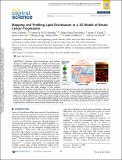| dc.contributor.author | Vidavsky, Netta | |
| dc.contributor.author | Kunitake, Jennie AMR | |
| dc.contributor.author | Diaz-Rubio, Maria Elena | |
| dc.contributor.author | Chiou, Aaron E | |
| dc.contributor.author | Loh, Hyun-Chae | |
| dc.contributor.author | Zhang, Sheng | |
| dc.contributor.author | Masic, Admir | |
| dc.contributor.author | Fischbach, Claudia | |
| dc.contributor.author | Estroff, Lara A | |
| dc.date.accessioned | 2021-10-18T19:05:47Z | |
| dc.date.available | 2021-10-18T19:05:47Z | |
| dc.date.issued | 2019-04 | |
| dc.date.submitted | 2018-12 | |
| dc.identifier.issn | 2374-7951 | |
| dc.identifier.uri | https://hdl.handle.net/1721.1/133040 | |
| dc.description.abstract | Copyright © 2019 American Chemical Society. Aberrant lipid accumulation and marked changes in cellular lipid profiles are related to breast cancer metabolism and disease progression. In vitro, these phenomena are primarily studied using cells cultured in monolayers (2D). Here, we employ multicellular spheroids, generated using the MCF10A cell line series of increasing malignancy potential, to better recapitulate the 3D microenvironmental conditions that cells experience in vivo. Breast cancer cell lipid compositions were assessed in 2D and 3D culture models as a function of malignancy using liquid chromatography coupled with mass spectrometry. Further, the spatial distribution of lipids was examined using Raman chemical imaging and lipid staining. We show that with changes in the cellular microenvironment when moving from 2D to 3D cell cultures, total lipid amounts decrease significantly, while the ratio of acylglycerols to membrane lipids increases. This ratio increase could be associated with the formation of large lipid droplets (>10 μm) that are spatially evident throughout the spheroids but absent in 2D cultures. Additionally, we found a significant difference in lipid profiles between the more and less malignant spheroids, including changes that support de novo sphingolipid production and a reduction in ether-linked lipid fractions in the invasive spheroids. These differences in lipid profiles as a function of cell malignancy and microenvironment highlight the importance of coupled spatial and lipidomic studies to better understand the connections between lipid metabolism and cancer. | en_US |
| dc.language.iso | en | |
| dc.publisher | American Chemical Society (ACS) | en_US |
| dc.relation.isversionof | 10.1021/ACSCENTSCI.8B00932 | en_US |
| dc.rights | Article is made available in accordance with the publisher's policy and may be subject to US copyright law. Please refer to the publisher's site for terms of use. | en_US |
| dc.source | ACS | en_US |
| dc.title | Mapping and Profiling Lipid Distribution in a 3D Model of Breast Cancer Progression | en_US |
| dc.type | Article | en_US |
| dc.identifier.citation | Netta Vidavsky, Jennie A. M. R. Kunitake, Maria Elena Diaz-Rubio, Aaron E. Chiou, Hyun-Chae Loh, Sheng Zhang, Admir Masic, Claudia Fischbach, and Lara A. Estroff, Mapping and Profiling Lipid Distribution in a 3D Model of Breast Cancer Progression, ACS Central Science 2019 5 (5), 768-780 | en_US |
| dc.contributor.department | Massachusetts Institute of Technology. Department of Civil and Environmental Engineering | |
| dc.relation.journal | ACS Central Science | en_US |
| dc.eprint.version | Final published version | en_US |
| dc.type.uri | http://purl.org/eprint/type/JournalArticle | en_US |
| eprint.status | http://purl.org/eprint/status/PeerReviewed | en_US |
| dc.date.updated | 2021-10-18T18:41:14Z | |
| dspace.orderedauthors | Vidavsky, N; Kunitake, JAMR; Diaz-Rubio, ME; Chiou, AE; Loh, H-C; Zhang, S; Masic, A; Fischbach, C; Estroff, LA | en_US |
| dspace.date.submission | 2021-10-18T18:41:18Z | |
| mit.journal.volume | 5 | en_US |
| mit.journal.issue | 5 | en_US |
| mit.license | PUBLISHER_POLICY | |
| mit.metadata.status | Authority Work Needed | en_US |
